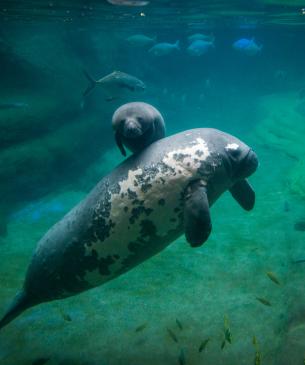Manatees are aquatic mammals, meaning they are warm-blooded and breathe air.
They are excellent swimmers that maneuver quite gracefully in the water. They typically travel at a speed of about three to five miles per hour.
At the Columbus Zoo, we’re dedicated to the conservation of Florida manatees, specifically through our participation in The Association of Zoos and Aquariums' (AZA) Saving Animals from Extinction (SAFE) program and support for the Manatee Rescue & Rehabilitation Partnership.
Scientific Name: Trichechus manatus
Conservation Status: Vulnerable
Size: Average length of an adult is 9 to 10 ft.
Weight: Range of 450 to more than 3,000 lbs. The average adult weight is 880 lbs.
Median Life Expectancy: Cannot be calculated














